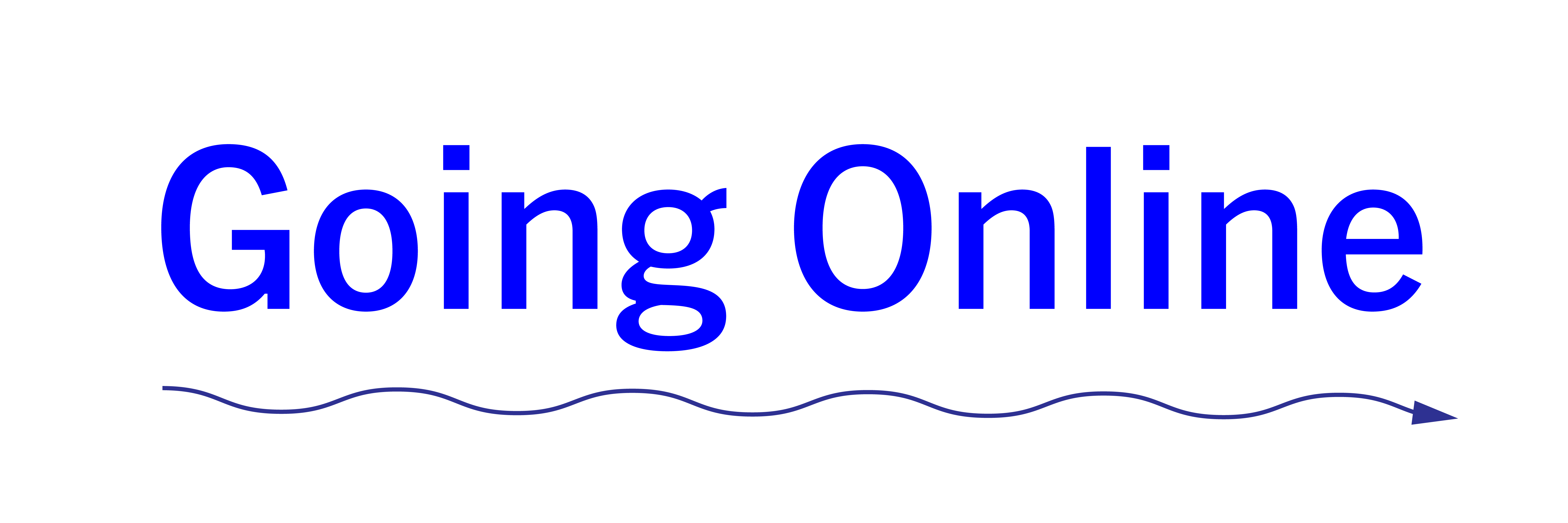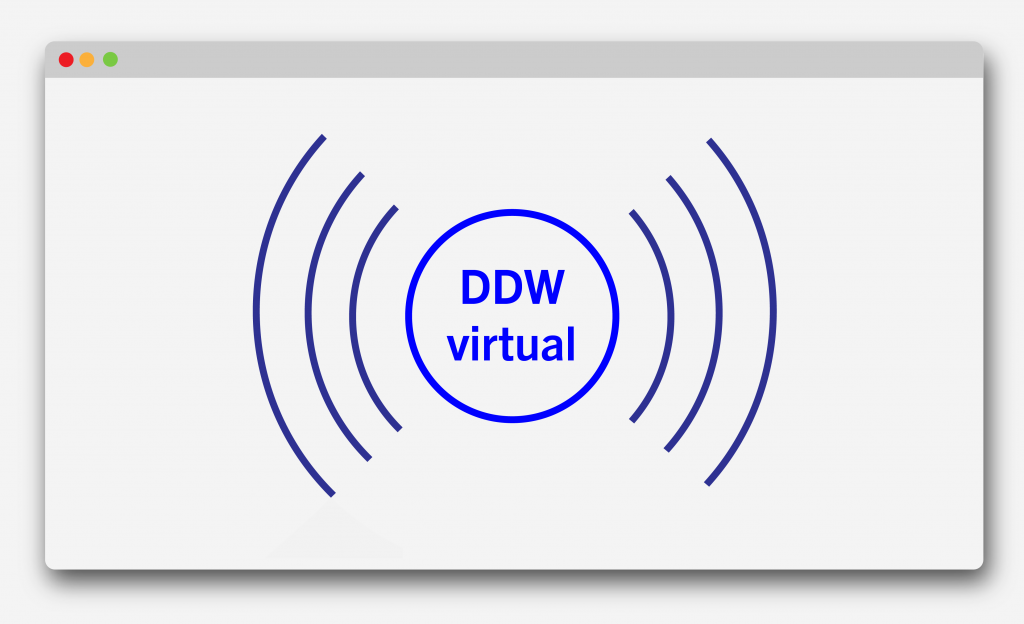
“Once everything is digital, and can stay on the internet forever, how do you create this ‘once-in-a-lifetime, can’t-be-repeated’ experience?”
– Lauren Lundholm
In the Going Online series, I talk with designers, curators, and program makers about online and hybrid events. The previous post dissected the media of Dutch Design Week 2020 – this time, we dive head first in to one of the big bottlenecks of online events: the concept of liveness. For online events, it can be challenging to catch and maintain the public’s attention, to make sure people feel engaged together. Researcher Esther Hammelburg states that liveness, ‘we are here and now together’, is build up out of time, place, and social context, which continuously takes up different shapes depending on media technologies.[1] Throughout the conversations I’ve had with stakeholders involved in Dutch Design Week (DDW), the concept of liveness came back over and over – a selection of insights:
Space
Building on the previous post about the simulation of space in the digital event media of DDW, I’ll start with the notion of space. When I ask Eszter Dolak from ‘(G)radio GS20’ how being in the physical space of Rararadio was different from hosting the radio show via an online platform, she says the following: “We had people calling in, so we had the experience of people who weren’t there. Maybe it would have been different if we could see them. With the phone calls, it was harder to keep the energy up. To have your own space is nice. If we would have done a Zoom call, we should have done something to make it more different. Having this physical space at this crazy underground radio station, brings this energy. That could have been lacking in a Zoom call. I think you can create that, give someone instructions, for example, to put loud music on.” This notion of togetherness that evolves from being in a cozy space together is one way to keep up the liveness.
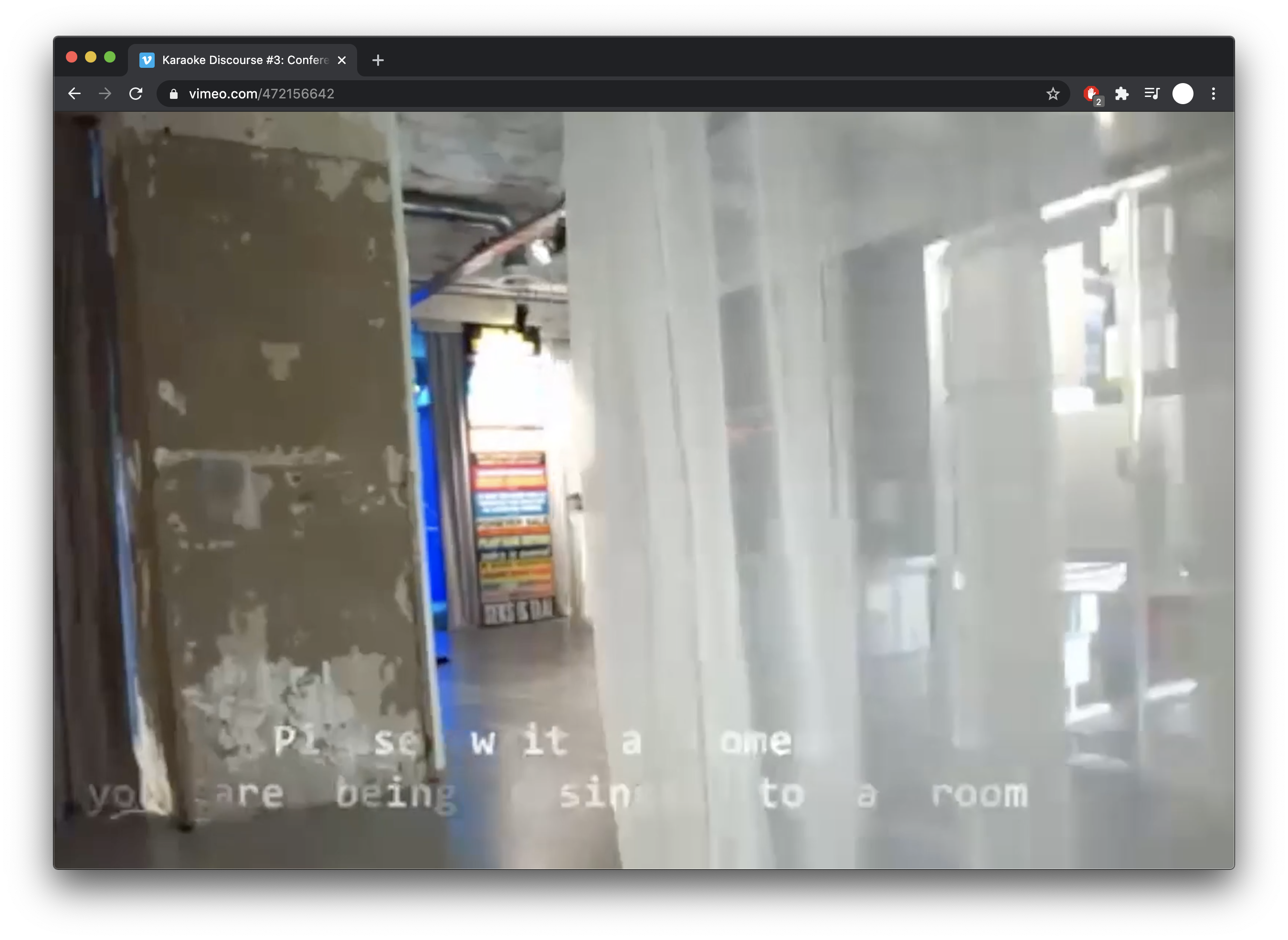
“Please wait a moment, you are being assigned to a room” – MU’s Karaoke Discourse
Similarly, the artist duo Arvid&Marie tell about their experiences with making use of the physical space in a livestream for MU’s event Karaoke Discourse during DDW: “In the last session of Karaoke Discourse, we created different spaces in the MU exhibition. In between a segment, we had a cameraman going from one space to another, so we were physically switching sessions. We talk about digital digital, but creating a connection with a physical space or thing really helps. We tried that with the performance for Dutch Design Week. We had an object behind us. It’s very important to keep a connection to a physical understanding while not just simulating it.” Whereas live-streaming from the home office might be more limited, there are great opportunities for experimenting with designing the environment for a stream.
Keeping up the energy
Online events can have the risk that audiences lose their attention. Finding ways to keep up the energy of the speakers and the audience is important. Arvid&Marie: “We found that it is really essential to create several moments to re-inform the discussion. Compared to the physical event, we kept it quite short. So only half of the event was the content, the other half was the discussion. We thought that was great. That’s why it’s interesting to be together, to talk to each other. Not just have an audience who is passively receiving. But, if you do that, you have the risk that at some point the energy of the questions die. We always had certain things to re-ignite the conversation. For example, in one of the events, we were impersonating famous designers and we got one of those designers, the real ones, to show up in the chat. Then this person said what they thought and created a whole new wave of questions and discussions afterward. What worked well for us is to loan out these discussion moments, really curated, to maintain the energy.”
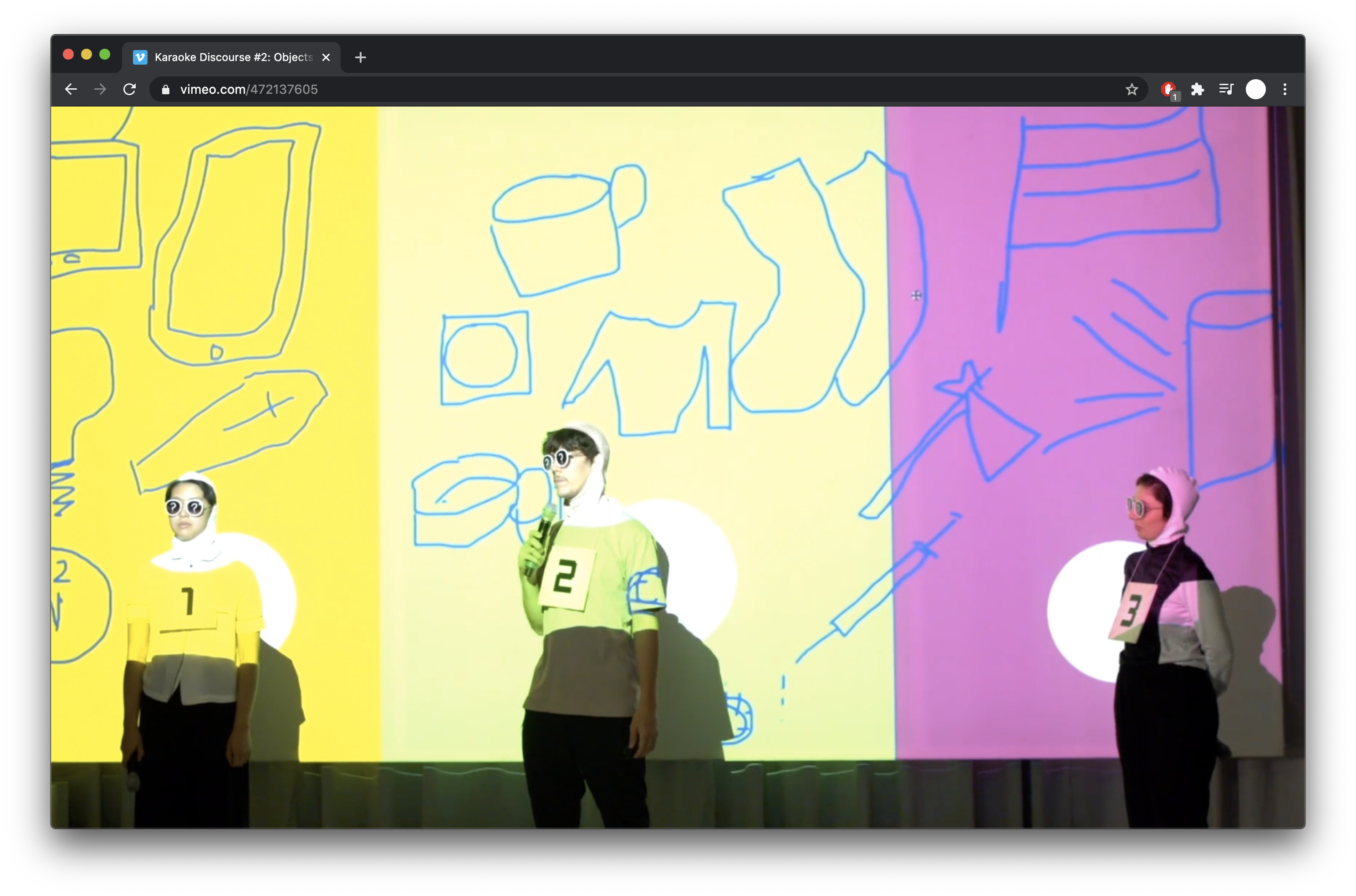
Another way to keep up the energy can be by alternating in types of content. “I think people really appreciate diversity, to have a talk, walking around, questions. I think the change helped with engagement, in 20 min we switched to different things. It feels like you’re zapping. People who came in later could join in better that way, they didn’t miss a whole part, every part was independent.” Isolde Hallensleben, former TV presentator and currently event host at MU, presented and moderated some of DDW TV talks. She voices a similar strategy, yet with a side-note: “If it’s just talking heads, I always like it when there is alternation, either film, photos, questions, … That stimulates another area in your brain. I think that’s very important. Without making it flat again. I am concerned that young generations have grown up with a lot of stimuli, which I see passing by on TikTok, that people can no longer just be. That there always has to be speed. I don’t believe that either.” The aim is alternation without over-stimulation.
Isolde stresses how during DDW TV, a physically present audience positively attributed to liveness: “We were in a super large room in which we almost drowned. I already enjoyed that during the broadcast of the award, the nominees were all present. Then there were at least 6 people around me. You already feel that that resonance is different if you can have a small audience. As an interviewer you immediately feel it when people lose attention or are very happy. That is important for the vibe of the event, whatever event it may be.” ‘Reading the room’ is much easier when there is some audience present in the space.
The Chat Function
One of the aspects that are particular to online events is the option of the chat. This is something that can be played with, as emphasized by Arvid&Marie: “In one the MU Karaoke events, people were discussing and the audience had to guess which objects they were talking about. I had in my mind how people would react if they were physically there. You ask them questions, and it’s really slow. But on the chat, people sent hundreds of ideas. They were constantly typing. That was really unexpected. You can take advantage of that dynamic.” Audiences can respond really quickly to questions and provide many more replies than they could have spotlighted one by one by the moderator. Yet, it’s tricky to navigate incoming questions from the audiences, especially since it takes a moment to respond. Isolde: “There is a delay in the medium itself: you hear something, type the question, and then there is already a delay,” […] “Many questions that come to mind, they link to what someone just said. If you ask them separately, it becomes a whole thing. Otherwise, something can be asked quickly in a kind of parenthesis, that finesse is not yet available in technology.” Just like physical events, the chat needs good moderation, both in the chat itself as in the stream.
Context
I ask Isolde if it’s different when you’re presenting a program when you know it’s being recorded. “Personally, I find that more unpleasant. If you are live present somewhere, even if it is virtually live, then it is a certain moment. It matters whether it is evening or morning, how the others got there, why they chose to be there. Those are many factors that turn something into the way it is. If you look at it later, some of those factors disappear and something that felt right or made sense at that time might not anymore. And as a presenter, I think that is something scary or naked. … It’s very much about context, cutting layers of context that can disappear by editing.” The question of context has always been relevant, but even more so today now that so much stays available online.
Although online platforms offer many possibilities to curate what is presented, uniformity in the presentation can make it hard to read that content contextually. Arvid&Marie: “People experience DDW in different ways. Some want to go in-depth in certain topics, like sustainable innovation. Others just want to browse and experience it for themselves. Some really want to buy products. There are very different approaches. A website is usually a very curated experience. You curate one way to interact with the content which may not leave these separate attitudes open. Everything looks exactly the same. It’s strange to first see this very commercial product presentation, and then you click on a refugee project below it, then there’s an iPhone-made film by a student, then there’s some text. It was rather confusing for us as visitors.” Digital events are still figuring this out. Thematics that used to be spatially separated now need another kind of user experience on the web. Whereas websites were primarily for documentation, they now have become the exhibition ‘site’, catering to many publics and functionalities simultaneously.
Workflows
Once events are (pre-)recorded for streaming, the technical and production aspects can drastically alter the workflows. This can be at the expense of liveness or coherency. When I ask Arvid&Marie about the process of filming their performance for the opening of DDW, they say: “Originally they intended for the panel to respond to the performance. But because of technical reasons, things had to be rescheduled, so we were filmed after the whole show was filmed. That’s where you see what went wrong. The performances are very disconnected from the rest of the show. It would have helped if it had been filmed in real order. The process in which this is done really influences the outcome.”
Every year at the graduation show of Design Academy Eindhoven, the Arena offers a platform for design discourse by the graduates. Usually, these presentations and talks are held in a space at the show, in 2020 they became part of the production of DDW TV. Ilja Schamlé, 2020 DAE alumna: “I signed up for the Arena and the Instagram Live. Then I was told that my work did not fit into the conversations of the Arena, and therefore I could not participate. The online production had to be more professional since live streaming is simply complicated. Production-wise it became more difficult. As a result, there were also professional requirements; what kind of conversation it would be, the planning had to be tighter, they had a script for what the conversation would be about. There was a make-up artist but no money for another talk.” The fact that these workflows change does not have to be problematic. But I would say it is vital to make sure the intended vision of the event remains, the livestream should not get in the way of the content.
Serendipity
Throughout the different conversations, one of the things that became apparent was the longing for randomness and serendipity online. When I ask Lauren what she missed most in the 3D Viewing Room, she says, “A networking feature, where you can have a conversation or meet with random people, to have a serendipitous conversation, they might stumble across it like at DDW. I would really have valued that to make it more engaging. I wasn’t sure what the appeal was to go to this website on this specific week since it would be online longer.” Ilja mentioned a similar tendency: “I can only reach people I already know. It stays within the niche world of the graduates and the DAE world and maybe a few companies that have an interest in representing designers. You do not reach an unpredictable group. I always found that strong about Dutch Design Week, it is very massive, it attracts a lot of public, so many people are not in a design or art context every day.” Back in the days, there was (the messiness of) Chatroulette, today apps like Tinder bring strangers together – both technologies are clearly not professional networking tools (and have their own problematics), but maybe there is something to take away from it.
Experiment!
All in all, some things work well online, some things don’t. There’s only one way to find out: by experimenting with the functionalities, inventing new formats, and sometimes try old ones again. That can mean giving in to the limitations. Isolde: “Online is a totally flat version of reality as we know it. Things you come up with are in that grid of flatness, in the simplicity. The complexity of normal biological interaction is not there. What thrives is what’s very simple.”
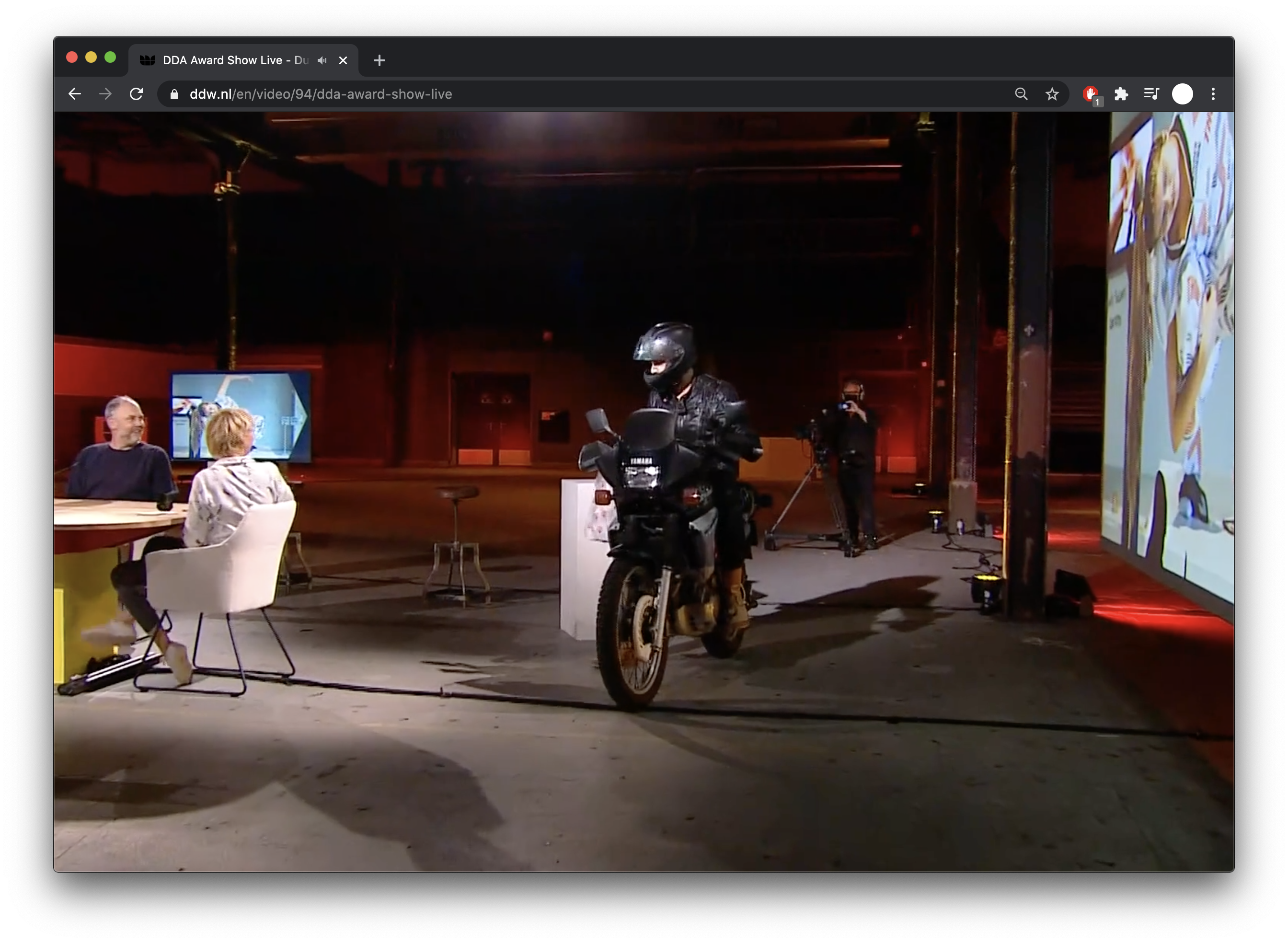
Regarding DDW Talks: “I felt a great need to play. It is also nice when you do not understand things, acting against that flatness. Throw in some things that make you think, ‘what is this?’. But then the danger is that it becomes bland? During the Dutch Design Awards, at the product design section, someone arrived on a motorcycle, gave me a takeaway pizza, and drove on again. Because I thought it was such a bizarre large space. Somehow it was bland but also very nice. … I am looking for a balance that makes the guests feel good, but that there is always room for improvisation, for things you don’t understand, for crazy things – without it becoming bland.” Keeping in mind the physical space, the vibe, online-specific possibilities, context, workflows, serendipity …. There’s a lot to experiment with.
References
[1] Hammelburg, E. (9 juli 2019). ‘De kracht van live!’ Keynote at Cross Media Café ‘Live is life’, organised by Media perspectives at Beeld en Geluid in Hilversum.


